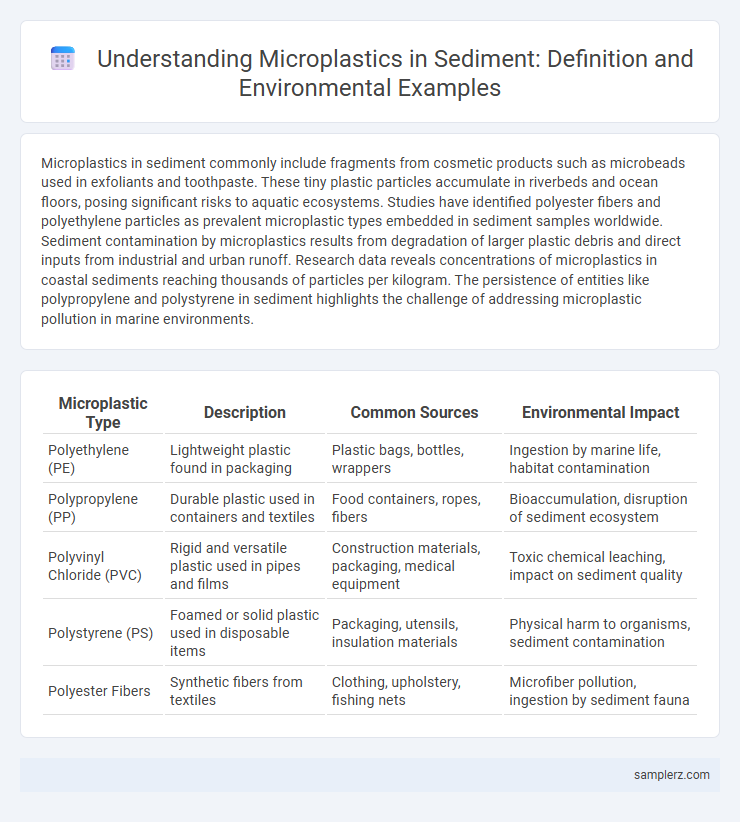Microplastics in sediment commonly include fragments from cosmetic products such as microbeads used in exfoliants and toothpaste. These tiny plastic particles accumulate in riverbeds and ocean floors, posing significant risks to aquatic ecosystems. Studies have identified polyester fibers and polyethylene particles as prevalent microplastic types embedded in sediment samples worldwide. Sediment contamination by microplastics results from degradation of larger plastic debris and direct inputs from industrial and urban runoff. Research data reveals concentrations of microplastics in coastal sediments reaching thousands of particles per kilogram. The persistence of entities like polypropylene and polystyrene in sediment highlights the challenge of addressing microplastic pollution in marine environments.
Table of Comparison
| Microplastic Type | Description | Common Sources | Environmental Impact |
|---|---|---|---|
| Polyethylene (PE) | Lightweight plastic found in packaging | Plastic bags, bottles, wrappers | Ingestion by marine life, habitat contamination |
| Polypropylene (PP) | Durable plastic used in containers and textiles | Food containers, ropes, fibers | Bioaccumulation, disruption of sediment ecosystem |
| Polyvinyl Chloride (PVC) | Rigid and versatile plastic used in pipes and films | Construction materials, packaging, medical equipment | Toxic chemical leaching, impact on sediment quality |
| Polystyrene (PS) | Foamed or solid plastic used in disposable items | Packaging, utensils, insulation materials | Physical harm to organisms, sediment contamination |
| Polyester Fibers | Synthetic fibers from textiles | Clothing, upholstery, fishing nets | Microfiber pollution, ingestion by sediment fauna |
Introduction to Microplastics in Sediments
Microplastics in sediments primarily comprise fragments smaller than 5 millimeters, originating from degraded larger plastic debris and synthetic textile fibers. These particles accumulate in marine and freshwater environments, affecting benthic ecosystems and posing risks to sediment-dwelling organisms. Recent studies reveal that microplastic concentration in sediments can reach thousands of particles per kilogram, indicating widespread environmental contamination.
Common Sources of Sedimentary Microplastics
Sedimentary microplastics commonly originate from fragmented plastic debris such as polyethylene terephthalate (PET) bottles, polyethylene bags, and fishing nets that accumulate in aquatic environments. Tire wear particles and synthetic fibers from textiles are prevalent contributors, often transported via urban runoff into sediment layers. Industrial discharges and wastewater treatment plant effluents further introduce microplastic particles, resulting in their widespread presence in marine and freshwater sediments.
Types of Microplastics Found in Sediments
Common types of microplastics found in sediments include fragments from larger plastic debris, microbeads from personal care products, and fibers shed from synthetic textiles. These particles vary in size, shape, and polymer composition such as polyethylene, polypropylene, and polystyrene, contributing to their persistence and potential ecological impact. Sediment analysis often reveals a high concentration of fibers and fragments, which serve as indicators of both land-based pollution sources and marine activity.
Sampling Techniques for Sedimentary Microplastics
Sedimentary microplastics are commonly sampled using grab samplers, core samplers, and dredges to accurately collect sediment from various depths and locations. Techniques such as sediment coring provide stratified samples, allowing for assessment of microplastic distribution and accumulation over time. Proper sample preservation and contamination control are critical to ensure reliable quantification and characterization of microplastic particles in sediment matrices.
Case Studies: Microplastic Sediment Contamination
Microplastic contamination in sediment has been extensively documented in case studies from coastal regions, such as the Baltic Sea and the Mediterranean Sea, revealing concentrations up to 25,000 particles per kilogram of dry sediment. Research highlights polyester and polyethylene as the predominant polymer types found in sediments, originating from urban runoff and wastewater effluents. These case studies emphasize the impact of microplastics on benthic ecosystems, including the ingestion by bottom-dwelling organisms and potential transfer through the food web.
Impacts of Microplastics on Benthic Ecosystems
Microplastics in sediment, such as polyethylene fragments and polyester fibers, disrupt benthic ecosystems by altering sediment structure and reducing oxygen availability for infaunal organisms. These particles are ingested by benthic invertebrates like polychaetes and bivalves, leading to physical harm and impaired feeding, growth, and reproduction. Accumulation of microplastics in sediments also facilitates the transfer of toxic pollutants, causing bioaccumulation and exacerbating toxic effects within benthic food webs.
Microplastic Concentrations in Coastal Sediments
Microplastic concentrations in coastal sediments have been documented at levels ranging from a few hundred to several thousand particles per kilogram of dry sediment, with hotspots near urbanized and industrial regions. Studies reveal that polymer types such as polyethylene, polypropylene, and polystyrene dominate these sediments, indicating widespread pollution from consumer products and packaging materials. These microplastic accumulations pose significant risks to benthic organisms and disrupt sedimentary ecosystems through physical and chemical contamination.
Riverine vs. Marine Sediment Microplastic Examples
Riverine sediments often contain microplastics such as polyethylene fragments and polystyrene beads derived from urban runoff and wastewater discharge. In contrast, marine sediments typically exhibit accumulation of microfibers from synthetic textiles and microbeads from personal care products due to ocean currents and coastal activities. These variations highlight distinct sources and transport mechanisms influencing microplastic distribution in freshwater versus marine environments.
Microplastic Accumulation in Urban vs. Rural Sediments
Microplastic accumulation in sediments varies significantly between urban and rural environments, with urban sediments often containing higher concentrations due to increased plastic waste and runoff. Studies show urban waterways can have microplastic levels exceeding 10,000 particles per kilogram of sediment, compared to fewer than 1,000 particles in rural areas. This disparity highlights the impact of urbanization on sediment contamination and the urgent need for targeted pollution reduction strategies.
Strategies for Reducing Sediment Microplastic Pollution
Effective strategies for reducing sediment microplastic pollution include implementing advanced wastewater treatment technologies that capture microplastics before they enter aquatic systems. Promoting the use of biodegradable materials and enforcing stricter regulations on plastic disposal significantly minimize microplastic accumulation in sediments. Restoration of wetlands and riparian buffers enhances natural filtration processes, preventing microplastic infiltration into sediment layers.

example of microplastic in sediment Infographic
 samplerz.com
samplerz.com